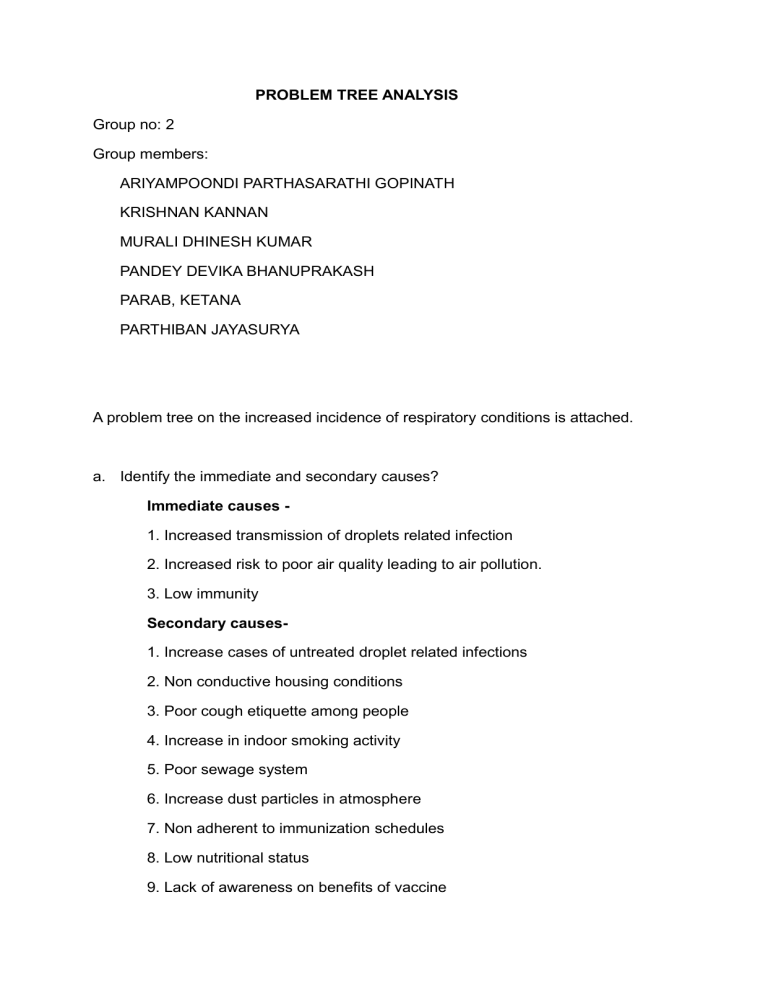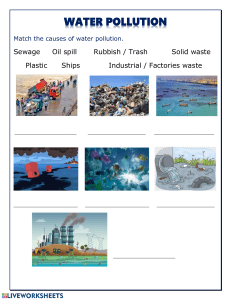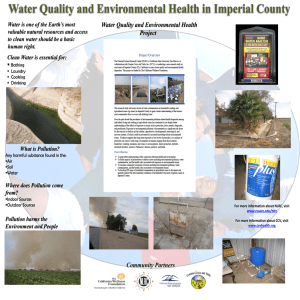
PROBLEM TREE ANALYSIS Group no: 2 Group members: ARIYAMPOONDI PARTHASARATHI GOPINATH KRISHNAN KANNAN MURALI DHINESH KUMAR PANDEY DEVIKA BHANUPRAKASH PARAB, KETANA PARTHIBAN JAYASURYA A problem tree on the increased incidence of respiratory conditions is attached. a. Identify the immediate and secondary causes? Immediate causes 1. Increased transmission of droplets related infection 2. Increased risk to poor air quality leading to air pollution. 3. Low immunity Secondary causes1. Increase cases of untreated droplet related infections 2. Non conductive housing conditions 3. Poor cough etiquette among people 4. Increase in indoor smoking activity 5. Poor sewage system 6. Increase dust particles in atmosphere 7. Non adherent to immunization schedules 8. Low nutritional status 9. Lack of awareness on benefits of vaccine b. Identify the immediate and secondary effects? Immediate Effects 1. Increased incidence of cough and colds 2. Increased perception of having asthma in the community 3. Increased perception of having pneumonia in the community Secondary Effects 1. Difficulty in doing activities of daily living 2. poor work performance or absence from work 3. Increased Hospitalisation 4. Poor school performance or Absence from school c. Based on the problem tree provided, select one immediate causes and create on objectives tree? Increase the risk of Wild life cardiovascular disease endangerment Crop of forest Accelerated Exacerbates existing respiratory damage global warming conditions ( eg Asthma) Irritation in the eyes, nose, Ozone depletion Acid rain throat and lungs. Increased risk of poor air quality leading to air pollution Outdoor air pollution Indoor air pollution Indoor smoking Poor sewage system activitie Vehicle exhaust Increase use of fumes mosquito repellant Fossil fuel based Increase use of as power plant dirty kitchen Construction and agricultural activities 4. Using SMART, please enumerate at least five goals to address the core problem? SMART ANALYSIS Cause: INCREASED RISK OF POOR AIR QUALITY LEADING TO AIR POLLUTIONS SPECIFIC: Air quality leading to pollution can be reduced on high air pollution days by staying indoors, reducing outdoor air infiltration to indoors, cleaning indoor air with air filters, and limiting physical exertion, especially outdoors and near air pollution sources. MEASURABLE: Create and begin the community organization program as soon as possible or within one year. Then provide information and free education about the cause and effects of air pollution (what and which makes people vulnerable to air pollution). Educate community about the AQI and person may plan outdoor activities when AQI is lower, usually in the morning or evening. The local media-newspapers, television and radio should always provide AQI reports telling the public when AQI levels are predicted to be unhealthy. ACHIEVABLE: After creating an organization in the community, we try to reach and accommodate with the other community organizations like this. Make the crew members interact with the people so that they can understand their problems and what makes them increase risk of air pollution. 1) Keep the greenery outdoorsIndoor plants are pretty, but they can also collect and foster the growth of mold, which later might give some chronic allergy. 2) Invest in an air purifierPlace it in the most commonly used areas of the house, these devices, can help capture some of the irritants that may trigger your symptoms. 3) Renewable fuel and clean energy productionThe most basic solution for air pollution is to move away from fossil fuels, replacing them with alternative energies like solar, wind and geothermal. 4) Eco-friendly transportation Government should also promote shifting to electric vehicles and hydrogen vehicles, and promoting shared mobility could reduce air pollution. 5) Reduce or eliminate fireplace home and wood stove use in kitchen. RELEVANT: Provide an education program outlining the health and environmental hazards of current problems that make air pollution. Combining the provision of new technologies with an education program that highlights the worth of the new prevention and treatment techniques helps meet the central goal of promoting more efficiency and improving the long- term health of local community members. TIMELY: Providing new measures within one year of preventing the increased risk of poor air quality. The projects and goals should have specific deadlines and timely goals to be completed , so the revenue spent on these does not get wasted in the allocated budget before the problem is solved.



